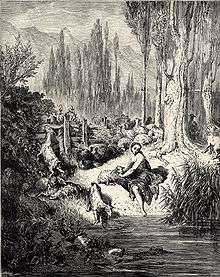Donkeyskin

Donkeyskin (French: Peau d'Âne) is a French literary fairytale written in verse by Charles Perrault. It was first published in 1695 in a small volume and republished in 1697 in Perrault's Histoires ou contes du temps passé.[1] Andrew Lang included it, somewhat euphemized, in The Grey Fairy Book.[2][3]
It is similar in style to folktales of Aarne-Thompson type 510B, unnatural love. Others of this type include Catskin, Little Catskin, Cap O' Rushes, Allerleirauh, The King Who Wished to Marry His Daughter, The She-Bear, Mossycoat, Tattercoats, The Princess That Wore A Rabbit-Skin Dress, and The Bear.[4]
Synopsis
A king had a beautiful wife and a rich castle, including a marvelous donkey whose droppings were gold. One day his wife died, after making him promise not to marry except to a woman whose beauty and attributes equaled hers. The king grieved, but was, in time, persuaded to seek another wife. It became clear that the only woman who would fit the promise was his daughter.
She went to her fairy godmother who advised her to make impossible demands as a condition of her consent: a dress as bright as the sun, a dress the colour of the moon, a dress all the colours of the sky, and finally, the hide of his marvelous donkey (which produced gold, and thus was the source of his kingdom's wealth). Such was the king's desire to marry her that he granted all of them. The fairy godmother gave her a marvelous chest to contain all she owned and told her that the donkeyskin would make an excellent disguise.

The princess fled and eventually found a royal farm where they let her work in the kitchen, despite her ugliness in the donkeyskin. On feast days, she would dress herself in the fine gowns her father had given her, and one such day, the prince came by her room and peeped through the keyhole. He fell in love at once, fell ill with his longing, and declared that nothing would cure him but a cake baked by Donkeyskin, and nothing they could say of what a dirty creature she was dissuaded him.
When Donkeyskin baked the cake, a ring of hers fell in it. The prince found it and declared that he would marry only the woman whose finger it fit. Every other woman having failed, he insisted that Donkeyskin try, and it fit. When she had dressed herself in her fine gowns, his parents were reconciled with the match. Donkeyskin later found that her father had remarried to a beautiful widow and everyone lived happily ever after, except the donkey.
Retellings and adaptation
- Unnatural Issue, a novel by Mercedes Lackey
- "The Tale of the Skin," a short story by Emma Donoghue
- Deerskin, a novel by Robin McKinley
- "Donkeyskin," a short story by Terri Windling
- "Donkeyskin," a poem by Midori Snyder (available online here)
- Pelzmantel: A Medieval Tale, a novel by K. A. Laity, Spilled Candy Books, 2003
- Peau d'âne a 1970 French film directed by Jacques Demy and starring Jean Marais and Catherine Deneuve (known in English by the titles Donkey Skin, Once Upon a Time, and The Magic Donkey)
- Sapsorrow aired on Jim Henson's series The Storyteller
- "The Color Master," a short post-modern fairytale by Aimee Bender detailing the struggle of the dressmakers.
- "Donkeyskin" or "Faith" is a character in Telltale's game series The Wolf Among Us, as are the Prince and King from this story.
- The Donkey's Hide, a 1982 Soviet film adaptation.
See also
References
- ↑ Perrault, Charles. "Donkeyskin". University of Pittsburgh. Retrieved 7 June 2011.
- ↑ Lang, Andrew (ed.). "Donkeyskin". The Grey Fairy Book. SurLaLune Fairy Tales. Retrieved 7 June 2011.
- ↑ Bottigheimer, Ruth. "Before Contes du temps passe (1697): Charles Perrault's Griselidis, Souhaits and Peau". The Romantic Review, Volume 99, Number 3. pp. 175-189
- ↑ Heiner, Heidi Anne. "Tales Similar to Donkeyskin". SurLaLune Fairy Tales. Retrieved 7 June 2011.
External links
| Wikisource has original text related to this article: |